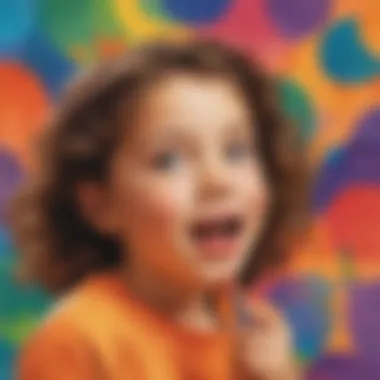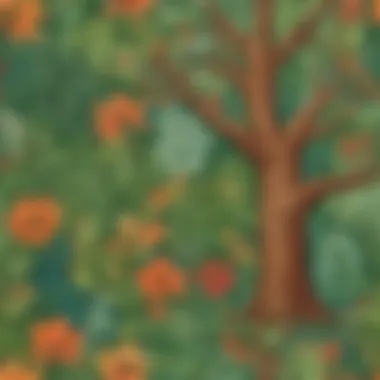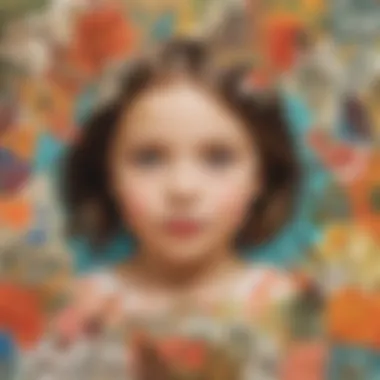Unlocking the Creative Potential: Art Activities for Three-Year-Olds


In this section, we will delve into a wealth of stimulating art activities specifically designed for three-year-olds. These activities are carefully curated to ignite the creative spark within young minds and foster a deep appreciation for art from an early age. By engaging in these hands-on projects, children can explore their artistic abilities and develop essential skills in a fun and educational manner.
Creative Messy Play
One exciting art activity for three-year-olds is engaging in creative messy play. This involves providing children with various materials such as finger paints, colored clay, and textured papers to freely express themselves through art. Through this tactile experience, children can explore different textures, colors, and shapes, enhancing their sensory perception and fine motor skills. Encouraging messy play also promotes creativity and imagination, allowing children to experiment and create in a non-restrictive environment.
Nature-inspired Art Exploration
Another captivating activity for three-year-olds is nature-inspired art exploration. This involves taking children outdoors to collect natural materials like leaves, twigs, and flowers to use in their art projects. By incorporating elements from nature, children can develop a deeper connection with the environment while unleashing their creativity. This activity encourages children to observe and appreciate the natural world around them, fostering a sense of wonder and curiosity.
Sensory Art Experiences
Sensory art experiences offer a multisensory approach to art exploration for three-year-olds. By incorporating elements such as scented paints, textured fabrics, and sound-producing materials, children can engage their senses while creating art. These experiences not only stimulate creativity but also enhance cognitive development by providing a holistic sensory experience. Through sensory art activities, children can express themselves in unique ways while honing their sensory awareness and creative abilities.
Collaborative Art Projects
Collaborative art projects provide three-year-olds with opportunities to work together and create art as a team. By engaging in group art activities like mural painting or collaborative drawings, children learn important social skills such as cooperation, communication, and sharing. These projects also promote peer interaction and a sense of community, fostering a collaborative spirit among young artists. Through collaborative art projects, children can explore the joy of creating together and appreciate the diverse contributions of each participant.
Conclusion
Introduction


In this article, we aim to navigate the realm of art activities specifically tailored for the curious minds of three-year-olds. Early exposure to art not only fosters creativity but also plays a crucial role in cognitive development during the formative years. By engaging in various artistic endeavors, children can enhance their sensory experiences and fine motor skills, laying a robust foundation for future learning.
Understanding the Importance of Art for Three-Year-Olds
Art serves as a medium of expression for young children, allowing them to communicate their thoughts and feelings in a non-verbal manner. For three-year-olds, art provides a platform to explore textures, colors, and shapes, nurturing their curiosity and imagination. Additionally, engaging in art activities at a young age can foster essential skills such as hand-eye coordination, spatial awareness, and emotional intelligence. By encouraging artistic expression in early childhood, parents and educators can help children develop confidence, problem-solving abilities, and a deep appreciation for creativity.
Exploration of Art Activities
Delving into the realm of art activities for three-year-olds is a crucial endeavor within this article. The significance of such exploration lies in fostering creativity and cognitive development at a pivotal age. Through hands-on experiences, children can enhance their motor skills, sensory awareness, and imaginative thinking. By engaging in diverse art forms, youngsters can express themselves freely, stimulating their artistic inclinations.
Mess-Free Finger Painting Techniques
When it comes to exploring art with toddlers, mess-free finger painting techniques offer a wonderful introductory experience. By using innovative tools like zip lock bags or plastic sheets, parents and teachers can provide a clean and safe environment for artistic expression. This activity not only encourages sensory exploration but also promotes hand-eye coordination and color recognition in young learners.
Creative Play with Play-Dough
Engaging children in creative play with play-dough is a delightful way to enhance their artistic skills. The malleable texture of play-dough allows for endless possibilities, from sculpting shapes to creating imaginative figures. Through this activity, kids can strengthen their fine motor skills, unleash their creativity, and learn basic principles of form and structure.
Nature-Inspired Art Projects
Exploring nature-inspired art projects introduces young minds to the beauty of the natural world. By using materials like leaves, flowers, and twigs, children can create stunning artworks that reflect the wonders of the environment. This activity not only nurtures a love for nature but also encourages exploration, creativity, and a deeper connection to the world around them.


Sensory Art Exploration
Sensory art exploration is a sensory-rich experience that engages children in a multi-sensory creative process. By incorporating various textures, scents, and visual elements into art activities, kids can explore their senses and express emotions through art. This approach not only stimulates cognitive development but also promotes self-expression and emotional well-being.
Collaborative Collage Making
Collaborative collage making fosters teamwork and creativity among young children. By working together to create a collective artwork using different materials and textures, kids learn to communicate, share ideas, and appreciate each other's contributions. This activity encourages social interaction, imagination, and the celebration of diversity in artistic expression.
Musical and Artistic Expression
Encouraging musical and artistic expression in three-year-olds is a harmonious way to integrate creativity and sensory experiences. By combining music and art activities, children can explore rhythm, movement, and visual expression simultaneously. This holistic approach nurtures a deeper appreciation for the arts, enhances cognitive skills, and fosters a well-rounded artistic development.
Benefits of Engaging in Art at a Young Age
Art plays a significant role in the development of young children, particularly three-year-olds 🎨 Engaging in artistic activities at a tender age provides a myriad of benefits that extend far beyond mere creativity. Research suggests that exposing young children to art fosters cognitive development, emotional intelligence, and enhances problem-solving skills. Through art, children learn to express themselves, cultivate their imagination, and develop a sense of aesthetic appreciation. By engaging in art from a young age, children are encouraged to explore their surroundings, experiment with different materials, and unleash their inner creativity. Furthermore, art activities promote hand-eye coordination, fine motor skills, and encourage attention to detail. In essence, art is not just about producing pretty pictures but about nurturing holistic development in children 🖌️.
Enhancing Fine Motor Skills and Coordination
A crucial aspect of engaging in art at a young age is the enhancement of fine motor skills and coordination ⭐ Through activities such as coloring, cutting, and drawing, children hone their hand muscles and refine their coordination. The process of holding a paintbrush or manipulating clay enhances dexterity and precision in movements, laying a strong foundation for future academic and physical endeavors. Moreover, engaging in art activities helps children develop patience, perseverance, and the ability to concentrate for extended periods of time. As they work on intricate art projects, children learn to control their hand movements, focus on details, and express their thoughts visually. In essence, by engaging in art, children not only produce beautiful creations but also refine their motor skills and boost cognitive development 🎨.
Tips for Facilitating Art Activities


Art activities for three-year-olds go beyond just providing supplies; they require thoughtful facilitation to ensure a rich artistic experience. Tips for facilitating art activities play a crucial role in nurturing creativity in young children. By creating a conducive environment for artistic exploration, parents and educators can help children unleash their imagination and develop essential skills. From setting up the art space to guiding the creative process, each step is vital in shaping a child's artistic journey. Emphasizing the importance of these tips, this section delves into key elements that can transform a regular art session into a captivating learning opportunity.
Creating a Safe and Inspiring Art Space
Establishing a safe and inspiring art space is fundamental for fostering creativity in three-year-olds. Safety measures such as child-friendly supplies, non-toxic materials, and supervision are paramount. Ensuring that the art area is well-organized and accessible encourages independent artistic expression. Inspirational elements like colorful artwork, nature finds, or art books can spark creativity and curiosity in young artists. By creating a space free from distractions and limitations, children are empowered to explore their creativity freely, boosting their confidence and enthusiasm for art.
Encouraging Creative Expression and Exploration
Encouraging creative expression and exploration in young children enhances their cognitive and emotional development. Providing open-ended art activities allows three-year-olds to experiment, make choices, and express themselves freely. Emphasizing the process over the final product nurtures a child's creativity and self-esteem. Positive reinforcement, encouragement of imaginative ideas, and active participation in art-making activities build a strong foundation for artistic growth. Supporting varied artistic expressions and valuing each child's unique style fosters a sense of accomplishment and joy in creating art.
Celebrating and Displaying Artwork
Celebrating and displaying a child's artwork not only boosts their confidence but also reinforces the value of creativity. Acknowledging a child's efforts by displaying their creations promotes a sense of pride and achievement. Rotating displays, creating personalized galleries, or even organizing mini art exhibitions at home can inspire children to continue exploring art. Engaging in conversations about their artwork, asking open-ended questions, and appreciating their creative choices enrich the artistic experience. By celebrating and showcasing their artwork, parents and educators validate a child's creativity, encouraging them to continue exploring and developing their artistic skills.
Conclusion
In the realm of exploring art activities tailored for three-year-olds, the importance of nurturing young artistic talent cannot be overstated. This conclusion serves as a pivotal point in encapsulating the significance of early exposure to art in facilitating children's creative expression and cognitive development. By engaging in a variety of stimulating art projects specifically designed for young minds, parents and educators play a critical role in fostering a deep appreciation for creativity in children. These activities are not merely pastimes but serve as crucial building blocks for honing artistic skills and enhancing cognitive abilities in young learners.
It is imperative to recognize that amidst the finger paintings, play-dough creations, and collaborative projects, lies the key to unlocking a child's potential for artistic expression and innovation. By providing a rich and engaging artistic environment, children are encouraged to explore, experiment, and express themselves freely, laying the groundwork for a lifelong journey of creative discovery and self-expression. Moreover, the act of celebrating and displaying artwork created by three-year-olds not only boosts their self-esteem but also instills in them a sense of pride and accomplishment, nurturing their budding artistic sensibilities.
As parents and educators navigate the realm of art activities for three-year-olds, it is essential to understand that these experiences go beyond mere creativity; they have lasting implications on a child's overall development. From enhancing fine motor skills and coordination to stimulating imagination and critical thinking, engaging in art at a young age has multifaceted benefits that extend far beyond the confines of a art project. Therefore, fostering young artistic talent through carefully curated activities is a profound investment in a child's future, laying the groundwork for academic success, self-expression, and innovative thinking.
Nurturing Young Artistic Talent
One of the fundamental aspects of nurturing young artistic talent involves encouraging creative expression and exploration without constraints. By granting children the freedom to experiment with different art mediums, techniques, and styles, parents and educators promote confidence and resilience in the face of creative challenges. This approach not only fosters a love for art but also instills a sense of curiosity and wonder that paves the way for continuous growth and self-discovery.
Additionally, celebrating and displaying children's artwork plays a vital role in nurturing their artistic talent. By showcasing their creations, children receive validation and appreciation for their efforts, fostering a sense of pride and accomplishment. This act of recognition serves as a motivating factor for young artists, inspiring them to further explore their artistic abilities and embark on new creative ventures. In essence, the act of celebrating and displaying artwork created by three-year-olds serves as a stepping stone towards building confidence, self-expression, and a lifelong love for the arts.







